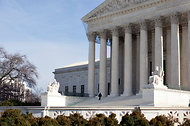Supreme Court to Rule on Immigration Law in Arizona
페이지 정보
작성자 관리자 작성일작성일 11-12-13 수정일수정일 70-01-01 조회7,029회관련링크
본문
<The Supreme Court agreed on Monday to decide whether Arizona may impose its tough anti-immigration law.>
Supreme Court to Rule on Immigration Law in Arizona
By ADAM LIPTAK
Published: December 12, 2011
WASHINGTON — In the space of a month, the Supreme Court has thrust itself into the center of American political life, agreeing to hear three major cases that could help determine which party controls the House of Representatives and whether President Obama wins a second term.
The court announced Monday that it would decide whether Arizona was entitled to impose tough anti-immigration measures over the Obama administration’s objections. The case joined a crowded docket that already included challenges to Mr. Obama’s signature legislative achievement, the 2010 health care overhaul law, and a momentous case on how Texas will conduct its elections.
The Texas case, which on Friday the court agreed to hear, could cause as many as four seats in the United States House of Representatives to change party control.
“It’s not just that these are big cases, but these are big cases that echo in the political arena,” said Nathaniel Persily, a professor of law and political science at Columbia University. “There is now a judicial forum for airing these political disputes.”
Arizona enacted its immigration law last year, and the Obama administration promptly sued to block four parts of it, saying they could not be reconciled with federal laws and policies.
The challenged provisions include a requirement that state law enforcement officials determine the immigration status of anyone they stop or arrest if officials have reason to believe that the individual might be an illegal immigrant. That provision also requires that the immigration status of people who are arrested be determined before they are released.
The law also makes it a crime under state law for immigrants to fail to register under a federal law and for illegal immigrants to work or to try find work. In addition, it allows the police to arrest people without warrants if they have probable cause to believe that they have done things that would make them deportable under federal law.
The United States Court of Appeals for the Ninth Circuit, in San Francisco, blocked all four provisions.
Applauding the Supreme Court’s decision to review that ruling, Gov. Jan Brewer, a Republican, was harshly critical of the administration.
“I was stunned at the audacity of the Obama administration to file suit against an individual state seeking to safeguard its people,” Ms. Brewer said in a statement. “That shock turned to outrage as the federal government proceeded to file suit against three more states — South Carolina, Alabama and now Utah — that followed Arizona’s lead.”
The health care and immigration decisions are likely to land in June, in the heat of the presidential campaign.
The court must act much faster in the Texas case, where its decision on Friday to stay the use of a set of election maps, created by federal judges, has thrown election planning there into disarray. Political observers believe that the new maps would increase the influence of Hispanic voters and thereby increase the number of Democrats in the House.
The court’s precedents point both ways in the health care case, and it is hard to say what the outcome will be. In the Arizona and Texas cases, recent decisions suggest that a majority of justices may look favorably on the positions of state officials, which would entail upholding the Arizona immigration law and rejecting at least a part of the court-drawn maps in Texas.
In May, the court upheld a different Arizona law, one that imposed harsh penalties on businesses that employed illegal immigrants. In a 2009 decision, Chief Justice John G. Roberts Jr., writing for the majority, expressed skepticism about the continuing vitality of a part of the Voting Rights Act of 1965 that the court in Texas relied on in substituting its own maps for ones drawn by the Legislature.
Legal scholars and court historians struggled to think of another recent Supreme Court term in a presidential election year with a similar pileup of cases with sharp political and societal consequences. The political impact of the term’s rulings may, moreover, be amplified by the court’s decision last year in Citizens United, which unleashed unlimited campaign spending by corporations and unions.
Some experts pointed to 1992, which featured a major abortion ruling and other big decisions. But the current term may be most reminiscent of the showdown between the Supreme Court and President Franklin D. Roosevelt in 1936, when the court struck down major pieces of New Deal legislation as well as a New York law establishing a minimum wage for women and children.
“There was a whole series of blockbuster cases, each with massive political implications and economic consequences for the country,” said Jeff Shesol, the author of “Supreme Power: Franklin Roosevelt vs. the Supreme Court.” That description sounds rather like the current term.
There is a great deal of happenstance in the shaping of a Supreme Court docket, and the fact that several cases arrived at the court at once does not necessarily suggest an agenda. The last term was lackluster; this one is lively.
“In most of these cases, it’s a coincidence of timing,” said Justin Driver, a law professor at the University of Texas.
The justices had little choice, for instance, in agreeing to hear a challenge to the health care law, as federal appeals courts were divided over its constitutionality and the Obama administration joined its opponents in urging the court to act quickly. But the Supreme Court did not have to signal that the case was a once-in-a-generation blockbuster by scheduling an extraordinary five and half hours of arguments.
<NYT>,2011/12/12








